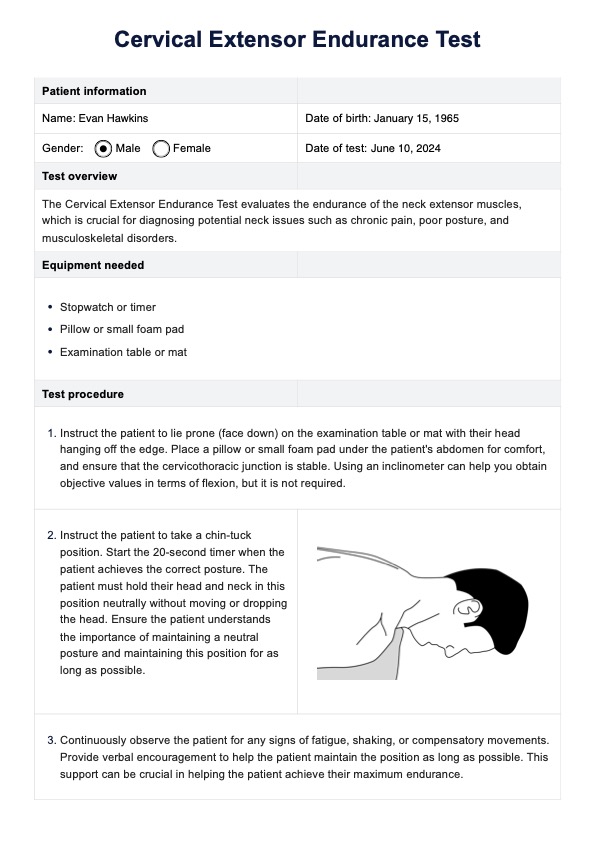Cervical Extensor Endurance Test
Learn about the Cervical Extensor Endurance Test, including its purpose, results interpretation, and benefits for healthcare professionals. Download our free template now!


What is the Cervical Extensor Endurance Test?
The Cervical Extensor Endurance Test is a diagnostic tool used to evaluate the endurance of the cervical extensor muscles and their role in supporting the upper cervical spine, which is crucial for maintaining proper posture and supporting the head and neck. This test benefits patients who experience neck pain, headaches, or upper back discomfort.
Typically, this test is administered to individuals with chronic neck pain, those recovering from neck injuries, or patients experiencing posture-related issues. It is also valuable for athletes and individuals with physically demanding jobs requiring prolonged head and neck stabilization periods.
By identifying endurance deficits in the cervical and deep neck extensors, healthcare providers can develop targeted rehabilitation programs to improve muscle strength and endurance in the cervical region. This will ultimately enhance overall neck function and reduce pain.
Cervical Extensor Endurance Test Template
Cervical Extensor Endurance Test Example
How to perform the Cervical Extensor Endurance Test
The Cervical Extensor Endurance Test is essential for evaluating the endurance of the neck extensor muscles. The test setup involves the patient lying prone on a flat surface. Here are the steps to perform this test correctly, ensuring accurate results and patient safety.
Step 1: Download our template
Begin by downloading our comprehensive Cervical Extensor Endurance Test template. This template provides all necessary sections to document patient information, test procedures, and results. You can download the template via the Carepatron app, on our website's resource library, or by clicking the button on this page.
Step 2: Prepare for the test
Instruct the patient to lie prone (face down) on the examination table or mat with their head hanging off the edge. Place a pillow or small foam pad under the patient's abdomen for comfort, and ensure that the cervicothoracic junction is stable. Using an inclinometer can help you obtain objective values in terms of flexion, but it is not required.
Step 3: Start the test
Instruct the patient to take a chin-tuck position. Start the 20-second timer when the patient achieves the correct posture. The patient must hold their head and neck in this position neutrally without moving or dropping the head. Ensure the patient understands the importance of maintaining a neutral posture and maintaining this position for as long as possible.
Step 4: Monitor for movement
Continuously observe the patient for any signs of fatigue, shaking, or compensatory movements. Terminate the test at the end of 20 seconds, or if the patient's chin lengthens and their neck goes into flexion. Keep in mind whether the patient's chin lengthened, whether they moved into neck flexion, or both.
Step 5: Record the results
Record whether the patient was able to complete the 20 seconds or not, and which movements they made. The interpretation section of our template will guide you in determining whether the results constitute that of a positive test. Allow the patient to rest and perform gentle neck stretches to cool down.
Results and interpretation of the Cervical Extensor Endurance Test
Interpreting the results of the Cervical Extensor Endurance Test involves measuring the duration the patient can maintain the test position during neck extension.
If the patient can hold the position for this duration without significant discomfort or muscle fatigue, it indicates good cervical extensor muscle endurance, constituting a negative test. However, if the patient experiences cannot maintain the position for the expected duration, it suggests weakness or endurance deficits in the cervical extensors, thus indicating a positive test.
However, that's not the end of it—it is important to differentiate between the endurance of deep and superficial neck extensors, which is why it is important to note what movements the patient made. If the patient's chin lengthens (neck extension) while maintaining a neutral posture, this indicates weakness of the deep neck extensors. If they move into neck flexion, it indicates global weakness or weakness of both deep and superficial neck extensors.
How will healthcare professionals benefit from our template?
Using our Cervical Extensor Endurance Test template offers several benefits for healthcare professionals. Here’s how it helps:
Streamlined documentation
Our template provides a structured format for recording test results, ensuring comprehensive and consistent documentation. This streamlines the process, saving time and reducing the risk of errors.
Enhanced patient communication
The template includes clear instructions and space for detailed notes, facilitating better patient communication. Healthcare providers can easily explain the test, discuss results, and outline the following steps, improving patient understanding and engagement.
Improved treatment planning
With organized and thorough documentation, healthcare professionals can develop more effective, personalized treatment plans. The template helps identify specific areas of weakness, allowing for targeted rehabilitation and better outcomes.
Commonly asked questions
The Cervical Extensor Endurance Test assesses the endurance of the cervical extensor muscles, which are crucial for neck stability and posture. It involves performing a chin tuck to evaluate the endurance of these muscles. The role of deep neck flexors is also assessed during the test to determine any motor control impairment or weakness, especially in patients with neck pain, headaches, or posture issues.
The Cervical Extensor Endurance Test requires the examinee to hold the chin-tuck position for 20 seconds. The test is negative if the patient holds for 20 seconds, and it is positive if the patient loses the chin tuck or goes into neck flexion.
If the test results indicate poor endurance, a targeted rehabilitation or manual therapy program to strengthen the cervical extensor muscles is recommended. Regular follow-ups can help monitor progress in physical therapy.






































































































